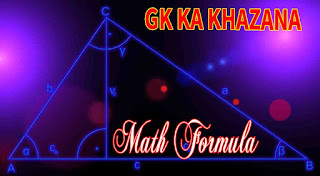- Home
- Gk Tricks
- Tutorials
- _General Knowledge
- __History
- __Geography
- __Indian Polity
- __Life Science
- __Physics & Chemistry
- __Economics
- __Computer
- __Sports
- __Miscellaneous
- _English
- _Math
- _Reasoning
- _Hindi
- _Current Affairs
- _Interview Tips
- Featured Posts
- Mock Test
- Download
- _Books
- _Android Apps
- Android Apps
- YouTube
- _How to learn
Ad Code
Random Posts
3/random/post-list
Competitive Books
Popular Posts
Contact
" अच्छी किताबे और अच्छे लोग तुरंत समझ में नहीं आते, उन्हें पढना पड़ता है। "
Important Math Formulas For Competitive Examination
Unknown
7:08 pm
1. When rate of discount is given Discount =
2. Simple Interest =
3. Principal =
4. Rate =
5. Time =
6. Principal = Amount - Simple Interest
7. Discount = MP - SP
♣♣♣♣♣♣♣♣♣♣♣♣♣♣♣♣♣♣♣♣♣♣♣♣♣♣♣♣♣♣♣♣♣♣♣♣♣♣♣♣♣♣♣♣♣♣♣♣♣♣♣♣♣♣♣♣♣♣♣♣♣♣♣♣♣♣♣♣♣♣♣♣♣♣♣♣♣♣
● Trigonometry Formulas
(i) The angle subtended at the centre of a circle by an arc whose length is equal to the radius of the circle is called a radian.
(ii) A radian is a constant angle. One radian = (2/π) rt. angle = 57°17’44.8” (approx.)
(iii) 1 rt. angle = 90° ; 1° = 60’ ; 1‘ = 60”.
(iv) 1 rt. angle = 100ᵍ ; 1ᵍ = 100’ ; 1‵ = 100‶.
(v) πᶜ 180° = 200ᵍ.
(vi) The circumference of a circle of radius r is 2πr where π is a constant; approximate value of π is ²²/₇; more accurate value of π is 3.14159 (approx.).
(ii) A radian is a constant angle. One radian = (2/π) rt. angle = 57°17’44.8” (approx.)
(iii) 1 rt. angle = 90° ; 1° = 60’ ; 1‘ = 60”.
(iv) 1 rt. angle = 100ᵍ ; 1ᵍ = 100’ ; 1‵ = 100‶.
(v) πᶜ 180° = 200ᵍ.
(vi) The circumference of a circle of radius r is 2πr where π is a constant; approximate value of π is ²²/₇; more accurate value of π is 3.14159 (approx.).
(vii) sin (A + B) = sin A cos B + cos A sin B.
(vii) sin ( A - B) = sin A cos B - cos A sin B.
(ix) cos (A + B) = cos A cos B + sin A sin B.
(x) cos (A - B) = cos A cos B + sin A sin B.
(xi) sin (A + B) sin (A - B) = sin² A - sin² B = cos² B - cos² A.
(xii) cos (A + B) cos (A - B) = cos² A - sin² B = cos² B - sin² A.
(xiii) tan (A+ B) = (tan A + tan B)/(1 - tan A tan B).
(xiv) tan (A - B) = (tan A - tan B)/(1 + tan A tan B).
(xv) cot (A + B) = (cot A cot B - 1)/(cot B + cot A).
(xvi) cot (A - B) = (cot A cot B + 1)/(cot B - cot A).
(xvii) 2 sin A cos B = sin (A + B) + sin(A - B).
(xviii) 2 cos A sin B = sin (A + B ) - sin (A - B).
(xix) 2 cos A cos B = cos (A + B ) + cos (A - B).
(xx) 2 sin A sin B = cos (A - B) - cos (A + B).
(vii) sin ( A - B) = sin A cos B - cos A sin B.
(ix) cos (A + B) = cos A cos B + sin A sin B.
(x) cos (A - B) = cos A cos B + sin A sin B.
(xi) sin (A + B) sin (A - B) = sin² A - sin² B = cos² B - cos² A.
(xii) cos (A + B) cos (A - B) = cos² A - sin² B = cos² B - sin² A.
(xiii) tan (A+ B) = (tan A + tan B)/(1 - tan A tan B).
(xiv) tan (A - B) = (tan A - tan B)/(1 + tan A tan B).
(xv) cot (A + B) = (cot A cot B - 1)/(cot B + cot A).
(xvi) cot (A - B) = (cot A cot B + 1)/(cot B - cot A).
(xvii) 2 sin A cos B = sin (A + B) + sin(A - B).
(xviii) 2 cos A sin B = sin (A + B ) - sin (A - B).
(xix) 2 cos A cos B = cos (A + B ) + cos (A - B).
(xx) 2 sin A sin B = cos (A - B) - cos (A + B).
♣♣♣♣♣♣♣♣♣♣♣♣♣♣♣♣♣♣♣♣♣♣♣♣♣♣♣♣♣♣♣♣♣♣♣♣♣♣♣♣♣♣♣♣♣♣♣♣♣♣♣♣♣♣♣♣♣♣♣♣♣♣♣♣♣♣♣♣♣♣♣♣♣♣♣♣♣
● Mensuration Formulas
1. Rectangle
i) Area=Length x Width
ii) Length = Area/Width
iii) Width = Area/Length
iv) (Diagonal)² = (Length)² + (Width)²
v) Perimeter=2 (Length+ Width)
2. Square
i) Area=side² =½ x (Diagonal)²
ii) Perimeter = 4 x Side
iii) Diagonal = √2x Side
3. Parallelogram
i) Area = Base × Height = b × h
ii) Area = 2 x √[s(s-a)(s-b)(s-d)] where a and b are the two adjacent sides and d is the diagonal of two sides.
iii) Perimeter = 2 x (l+b),Where l and b are adjacent sides of the parallelogram.
4. Rhombus
i) Area = ½ x product of diagonal
ii) Perimeter = 4 x Side
iii) Side = ½ x √(d₁² + d₂²) where d₁ and d₂ are two diagonal of rhombus.
5. Triangle
i) Area = ½ x Base x Height
ii) Area = √[s(s-a)(s-b)(s-c)] where S =½ x(a+b+c)
6. Equilateral triangle
i) Area = √3/4 x (Side)² or ½ x ah
ii) Height = √3/2 x a
iii) Perimeter = 3x Side
7. Trapezium
i) Area = ½ x (sum of parallel sides x perpendicular distance between the parallel sides)
ii) Height (h) = 2∕k x √[s(s-k)(s-c)(s-d)] where k = a-b and s = k+c+d/2
iii) Perimeter = a+b+c+d
8. Circle
i) Circumference = 2πr
ii) Area = πr²
iii) Arc AB = 2πrø/360°
iv) Perimeter of Arc AB = 2πrø/360° + 2r
v) Area of sector AB = πr²ø/360° or ½ x Arc AB x r
9. Cube
i) Volume = a³ cubic units
ii) Surface = 6a² sq. units
iii) Diagonal = √3a units
10. Cuboid
i) Volume = Length x Breadth x Width cubic units
ii) Whole surface = 2 ( lb + bh + hl) sq. units
iii) Diagonal = √(l² + b² + h² ) units
11.Cylinder
i) Volume =πr²h cubic units
ii) Total surface area = 2πr²+2πrh sq. units
iii) Curved surface area = 2πrh sq. units
12. Cone
i) Slant height (l) = √(h² + r² )
ii) Volume of cone = ⅓ πr²h cubic units
iii) Curved surface area =πrl sq. units
iv) Total surface area = πr²+πrl sq. units
13. Sphere
i) Volume = 4/3πr³ cubic units
ii) Surface area = 4πr² sq. units
14. Hemisphere
i) Volume = 2/3 πr³ cubic units
ii) Curved surface area = 2πr² sq. units
iii) Total surface area = 3πr² sq. units
15. Frustum of a Cone
i)Slant height (l)=√{(h² +(R - r )²}units,where r =top radius,R=base radius,h=height,s=slant height
i) Volume = πh/ 3 x (r² + rR + R²) cubic units
ii) Total surface Area = π{(R + r)l + r² + R²} sq. units
iii) Curved surface area = π(R + r)l sq. units
16. Prism
i) Volume = Base area x height
ii) Lateral Surface area = perimeter of the base x height
(ii) Whole surface area = Area of the lateral faces + 2 × area of the base.
17. Pyramid
i) Volume =13 × area of the base × height.
ii) Length = Area/Width
iii) Width = Area/Length
iv) (Diagonal)² = (Length)² + (Width)²
v) Perimeter=2 (Length+ Width)
2. Square
i) Area=side² =½ x (Diagonal)²
ii) Perimeter = 4 x Side
iii) Diagonal = √2x Side
3. Parallelogram
i) Area = Base × Height = b × h
ii) Area = 2 x √[s(s-a)(s-b)(s-d)] where a and b are the two adjacent sides and d is the diagonal of two sides.
iii) Perimeter = 2 x (l+b),Where l and b are adjacent sides of the parallelogram.
4. Rhombus
i) Area = ½ x product of diagonal
ii) Perimeter = 4 x Side
iii) Side = ½ x √(d₁² + d₂²) where d₁ and d₂ are two diagonal of rhombus.
5. Triangle
i) Area = ½ x Base x Height
ii) Area = √[s(s-a)(s-b)(s-c)] where S =½ x(a+b+c)
6. Equilateral triangle
i) Area = √3/4 x (Side)² or ½ x ah
ii) Height = √3/2 x a
iii) Perimeter = 3x Side
7. Trapezium
i) Area = ½ x (sum of parallel sides x perpendicular distance between the parallel sides)
ii) Height (h) = 2∕k x √[s(s-k)(s-c)(s-d)] where k = a-b and s = k+c+d/2
iii) Perimeter = a+b+c+d
8. Circle
i) Circumference = 2πr
ii) Area = πr²
iii) Arc AB = 2πrø/360°
iv) Perimeter of Arc AB = 2πrø/360° + 2r
v) Area of sector AB = πr²ø/360° or ½ x Arc AB x r
9. Cube
i) Volume = a³ cubic units
ii) Surface = 6a² sq. units
iii) Diagonal = √3a units
10. Cuboid
i) Volume = Length x Breadth x Width cubic units
ii) Whole surface = 2 ( lb + bh + hl) sq. units
iii) Diagonal = √(l² + b² + h² ) units
11.Cylinder
i) Volume =πr²h cubic units
ii) Total surface area = 2πr²+2πrh sq. units
iii) Curved surface area = 2πrh sq. units
12. Cone
i) Slant height (l) = √(h² + r² )
ii) Volume of cone = ⅓ πr²h cubic units
iii) Curved surface area =πrl sq. units
iv) Total surface area = πr²+πrl sq. units
13. Sphere
i) Volume = 4/3πr³ cubic units
ii) Surface area = 4πr² sq. units
14. Hemisphere
i) Volume = 2/3 πr³ cubic units
ii) Curved surface area = 2πr² sq. units
iii) Total surface area = 3πr² sq. units
15. Frustum of a Cone
i)Slant height (l)=√{(h² +(R - r )²}units,where r =top radius,R=base radius,h=height,s=slant height
i) Volume = πh/ 3 x (r² + rR + R²) cubic units
ii) Total surface Area = π{(R + r)l + r² + R²} sq. units
iii) Curved surface area = π(R + r)l sq. units
16. Prism
i) Volume = Base area x height
ii) Lateral Surface area = perimeter of the base x height
(ii) Whole surface area = Area of the lateral faces + 2 × area of the base.
17. Pyramid
i) Volume =
ii) Lateral Surface area = 12 × perimeter of the base x slant height.
iii) Whole surface area = area of the lateral faces + area of the base.
iii) Whole surface area = area of the lateral faces + area of the base.
♣♣♣♣♣♣♣♣♣♣♣♣♣♣♣♣♣♣♣♣♣♣♣♣♣♣♣♣♣♣♣♣♣♣♣♣♣♣♣♣♣♣♣♣♣♣♣♣♣♣♣♣♣♣♣♣♣♣♣♣♣♣♣♣♣♣♣♣♣♣♣♣♣♣♣♣♣
Ratings:
Platform:
WindowsSubscribe Us
Categories
Wikipedia
खोज नतीजे
" मैं नरक में भी अच्छे ज्ञान का स्वागत करुँगा, क्योंकी उनमें वह शक्ति है कि जहाँ वे होगी वहीं स्वर्ग बन जायेगा "
Random Posts
3/random/post-list
Recently Published G.K. Tricks
3/G.K.Tricks/post-list
Popular Posts

Indian Polity Tricks -1
11:40 am

Computer Question - 4
4:39 pm
Footer Menu Widget
Copyright ©
Gk ka Khazana













0 टिप्पणियाँ